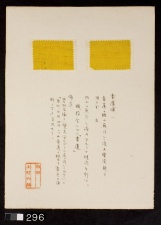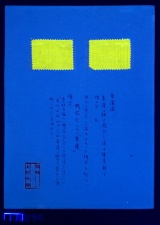Difference between revisions of "Ouren (Goldthread) - right (296 R)"
Jump to navigation
Jump to search
(username removed) |
m (MDerrick moved page Ouren - right (296 R) to Ouren (Goldthread) - right (296 R) without leaving a redirect) |
||
| (One intermediate revision by one other user not shown) | |||
| Line 5: | Line 5: | ||
| 296 | | 296 | ||
|- | |- | ||
| − | ! scope="row"| | + | ! scope="row"|Uemura number / title |
| − | | | + | | ; "Haze-some 25" |
|- | |- | ||
! scope="row"|Folder location | ! scope="row"|Folder location | ||
| Line 44: | Line 44: | ||
| - | | - | ||
|- | |- | ||
| − | ! scope="row"| | + | ! scope="row"|Uemura's notes |
| − | | The dyeing technique was recorded in the Buyakuryo ( | + | | The dyeing technique was recorded in the Buyakuryo (), the 8th century AD, Japan. In the list compiled by the Ministry of Forestry, it was recorded that the root and stem of this plant were used as a yellow dye in Thoku, Chugoku and Shikoku regions in Japan. |
|- | |- | ||
| − | ! scope="row"| | + | ! scope="row"|Uemura's date |
| Kyoto | | Kyoto | ||
|} | |} | ||
| − | [[Category: | + | [[Category:Uemura dye archive]] |
Latest revision as of 18:33, 23 June 2020
| Museum number | 296 |
|---|---|
| Uemura number / title | ; "Haze-some 25" |
| Folder location | 4th shelf |
| Sample location | right (296 R) |
| Fiber type | silk |
| Color | yellow |
| Dyestuff (Japanese common name) | 黄蓮 : Ouren |
| Dye (English common name) | Goldthread |
| Dyestuff (botanical name) | Coptis japonica (Thunb.) Makino var. anemonifolia (Siebold et Zucc.) H.Ohba |
| Plant part | root / dried (?) |
| Dyestuff extraction | boiled in water |
| Auxiliary agent in dye bath | - |
| Mordant | - |
| Other auxiliary agent | - |
| Uemura's notes | The dyeing technique was recorded in the Buyakuryo (), the 8th century AD, Japan. In the list compiled by the Ministry of Forestry, it was recorded that the root and stem of this plant were used as a yellow dye in Thoku, Chugoku and Shikoku regions in Japan. |
| Uemura's date | Kyoto |

